What Rhodo is that?
The genus or group of plants known as rhododendrons (from Greek, meaning “rosetree”) includes about 1000 species worldwide, including all the vireyas and azaleas. We grow over 500 of these species in our Garden. This Catalogue lists some of the Rhododendron species and hybrids found in our Garden. Our hybrids have been cultivated by several generations of Rhododendron lovers and are unique to the Emu Valley Rhododendron Garden.
To ask about specific plants or rhododendrons which may be available for sale, please send an email to our Horticulturist. Currently we do not have the ability to post any plants beyond Tasmania’s borders. Stock levels and varieties vary seasonally.
Did you know?
Azaleas are but one group of Rhododendrons. Apart from the better known Indica or Kurume hybrids, there are many other types, including the exquisite Deciduous Azaleas with brilliant gold and orange tones and beautiful perfume.
The Ericaceae (Heaths and Heathers) Plant Family are primarily found in Eastern Asia and the Himalayan region, as well as North America and Europe, but only two species are found in Australia in the high mountains in Queensland: Rhododendron lochiae and Rhododendron viriosum, (both being vireyas). Vireya Rhododendrons are plants of tropical origin with quite vivid colours that will grow very successfully in areas where frosts can be avoided. These beautiful plants need frequent watering and perfect drainage, but can reward the grower with flowers to 2 or 3 times per year. Give them plenty of sun.
There are many more unusual Rhododendrons species. These range from prostrate plants with tiny flowers to huge trees which may reach 30 metres at maturity, with huge trusses of flowers like fluted goblets. There are also many different leaf forms which can enhance the garden at times when there are no flowers.
Many Rhododendrons are perfumed. These include the Deciduous Azaleas, Vireyas, Lepidotes, and many of the species.
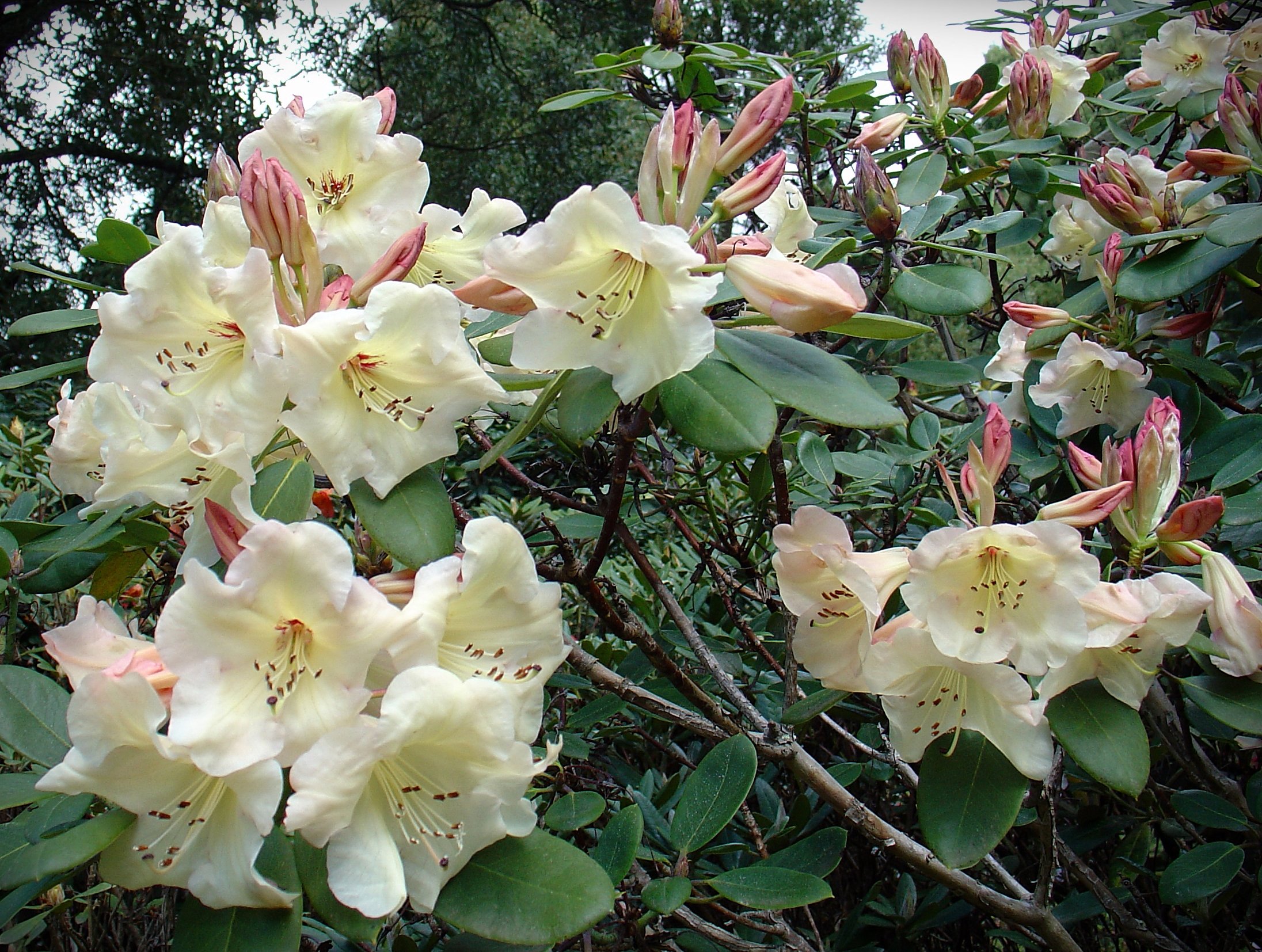
R. 'Golden Dream' is the result of a cross of R.campylocarpum x R. ‘Naomi’ by Lionel de Rothschild from Exbury Garden in the UK and introduced by him in 1935 along with other members of the ‘Carita’ Group. Sometimes referred to as Carita’s ‘Golden Dream.’ When the Australian Rhododendron Society North-West Tasmania branch was founded in the early 1980’s ‘Golden Dream’ among many other hybrids became more available and after much discussion ‘Golden Dream’ was a unanimous choice as that is all it was then -a dream – considering the formidable gully we had to tackle before anything could be planted. A local rhododendron grower and enthusiastic member, Trevor Crawford, supplied the original plant. Over the weekend of the 7-8thNovember 1981 the A R S held its first meeting in Tasmania and our own Bob Malone became president of that auspicious body and on the Sunday morning a number of members and delegates trudged along a track made by Hilary’s cows and arrived at the highest point on the valley floor where the outgoing A R S president, Dr. Chris Laurie from South Australian Branch planted the first rhododendron ‘Golden Dream’ surrounded by native bush.

1988, the “City of Burnie” rhododendron was named in honour of Burnie receiving "City" status in April that year. It then became the floral emblem of Burnie. Cross: Noyo Chief x Matador
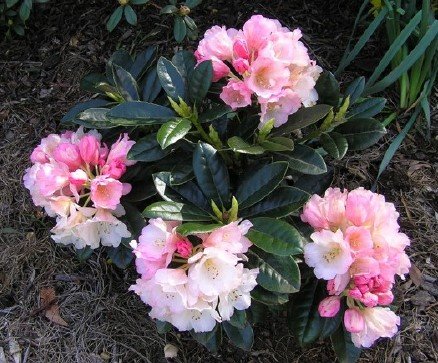
The late Dr Noel Sullivan was a keen hybridizer. He constantly looked for parents which would give not only delightful flowers, but also added interest in the foliage. One such hybrid was the cross between R. 'Bambi' (yakushimanum x 'Fabia Tangerine') and R. 'Morning Magic' (yakushimanum x 'Springbok'). In 1995 Noel said “I have great hopes for a seedling that will flower this year, and if up to expectations, this cross between R. 'Bambi' and R. 'Morning Magic', might well be named 'Sheer Magic' for the foliage is outstanding, but some time must elapse for the plant form to be assessed.” Time has elapsed and certainly the plant has lived up to his expectations as both leaves and flowers show the strong influence of R. yakushimanum – the leaves have a dark green shiny surface with a dark fawn indumentum and the flowers are semi double deep pink in bud opening to a paler pink. It grows to 80cms in a nice tight mound and when in flower lives up to its name.

Rhododendron pachypodum. This rather delightful member of the Maddenia Subseries grows well here at Emu Valley. In bud this bush opens from a very nice apricot pink to become large white flushed pink flowers with a lemon-yellow blotch covering the bush from mid October, and the perfume is delightful. George Forrest first collected pachypodum in August 1913 growing in open scrub and among pine forests on the western slopes of the Tali Range, Western Yunnan and introduced it to Western gardens in the same year, where it was found to grow to 1-1.5 meters in sheltered areas. Other collectors were later to discover it in Guangdong in China and in Upper Burma.

Rhododendron protistum var. giganteum. At Emu Valley our plant is around 30 years old and has been flowering well for the last three years. The new leaves develop indumentum around the edges, another sign that our R. protistum is starting to mature. R.protistum has a wide distribution in the wild from Yunnan to South-east Tibet, East Arunachal Pradesh, North-east Upper Burma and North Vietnam. The flowers are tubular-campanulate produced in large trusses of up to 30 and can range in colour from pale rose, crimson-purple or rosy-crimson. The leaves are also quite large 50 long x 90 mm wide.

Rhododendron lepidostylum. Some rhododendrons are renowned for spectacular flowers while others produce interesting foliage. R. lepidostylum fits well into the latter. This and the beautiful elipidote R. campanulatum subsp. aeruginosum have the bluest foliage in the genus, for those who are interested in exotic colours in the landscape. Other interesting features are the rather densely bristly margins to the leaves, branchlets, pedicels, calyx and to some extent the flower tube, these bristles are white while the underside is quite glaucous, especially the young leaves producing quite an interesting feature. The flower colour is pale yellow or yellow with or without orange spots. Unfortunately the new growth appears at the same time as the flowers so they tend to get a little lost but the beautiful bluish-green foliage covering the bush more than makes up for this.

Rhododendron genestierianum. S.E. Tibet, Upper Burma and Yunnan have produced many remarkable and beautiful rhododendrons, even the occasional strange ones. R. genestierianum is one such oddity, the leaves are elliptic-oblanceolate with a very sharp pointed tip. The underside is very glaucous and new growth is a reddish-purple. Nothing remarkable about that, you say, but when you add the deep plum- purple very fleshy tubular-campanulate 1.2-1.8cm long flowers with a glaucous bloom and a sharply bent style in trusses of up to 15 flowers may be then its time to take a second look.

Rhododendron kawakamii grows into a shrub to 1.5m producing its obovate to elliptic leathery leaves in loose pseudowhorls, the upper surface dark green, lower surface covered with small brown scales. The white to yellow flowers are produced in terminal clusters of 3-7 and are saucer shaped. At Emu Valley we find it grows well in our vireya section, where the bright yellow flowers appear from May onwards. This bright little species of sub-genus vireya is native to the Chungyang Mountain Range in Taiwan where it is found growing on the lower slopes of Mt. Morrison in humid rain forests, usually as an epiphyte at elevations of 2000-2135m.

Rhododendron trichanthum. This rhododendron is quite unusual in that the flowers, leaves, leaf stalks and branchlets are all densely covered with hair/ bristles; this feature separates it from other species in this subsection. R.trichanthum can be a low shrub from one metre and up to six meters in height in the wild, and this growth can be dense in the lower plants to sparse in the taller ones depending on local conditions. Ours are only getting to flowering size so time will tell. Flower colour is quite variable, ranging from bluish dark plum, reddish-purple, pale purple to bluish-mauve sometimes with a brown or green flare.

One of the easiest to grow rhododendron species of dwarf, mound forming habit and valued as a ground cover is R. keleticum, or to give it its correct title R. calostrotum Ssp. keleticum. This subspecies was discovered by George Forrest in August 1919 in the Salwin-Kiu-chiang Divide, south-east Tibet: and later found by Frank Kingdon-Ward in north-east Upper Burma. Joseph Rock sent seeds in 1949 under the label No. 58 from north-west Yunnan. These collections made their way to many of the great gardens of Great Britain. In our Garden it forms a very compact, rounded spreading shrub about 45cms high, flowering in late November. Note the scaly dark green leaves, these being glaucous underneath. The flowers are widely funnel-shaped, deep crimson purple with crimson spots. A delightful species for a rock garden.

One of the earliest lepidote rhododendrons we planted at Emu Valley was R.maddenii ssp. maddenii in both white and pink flowered forms. These plants grew well and soon become large bushes displaying highly perfumed flowers in early November each year, a much-admired plant by the many visitors who pass them. First discovered by J.D.Hooker in 1849 at Choongtam in Sikkim, it was later found by other collectors in different locations in Sikkim and Bhutan growing in oak and rhododendron thickets and on dry hillsides The stems and branches have beautiful brown flaking bark, which shines in the sunlight. In the white flowered form the upper surface of the leaves are dark green and usually matt whereas the pink flowered form has dark green somewhat shiny upper surface, the under surface of both forms densely scaly. At Emu Valley both colour forms can be viewed near the rockery beside the road leading to the main gazebo, or if you are up for a walk they can be viewed on the middle road in Sikkim and Bhutan.
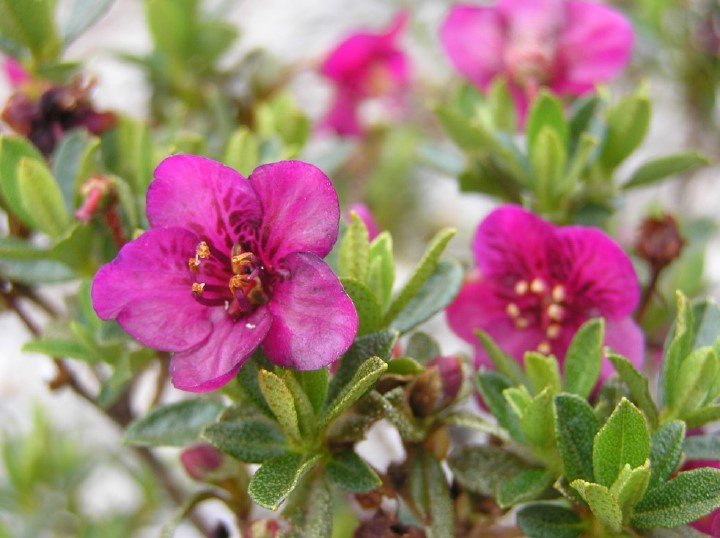
(meaning beset with scales) Rhododendron lepidotum has a wide distribution in its native countries ranging from Nepal in the west of the Himalayas to Sikkim, Bhutan and on into Burma and Yunnan. The growing conditions are just as diverse from cliffs and stony places, amongst scrub, grassy slopes, and open pasture, by streams and in conifer forests. Therefore, not surprisingly, it is a very variable plant ranging from only centimeters in height up to 1500mm and either deciduous or evergreen. The leaves are large or small and the flower colour ranges from pink, purple, rose, scarlet, crimson or yellow with or without crimson, rose to even green spots. The species was first introduced to western gardens by J. D. Hooker in 1850 from Sikkim and other collectors soon followed which led to 10 or more different forms in cultivation, many becoming named variations. Now before you rush out to see something spectacularly brilliant at Emu Valley let me tell you that our plants are around 300mms high with small leaves, the upper surface pale green and the lower surface covered in brownish scales. The flowers are only about the size of a viola but they sit up proudly to look at you on hairy stalks and the colour is a deep shade of cerise and very cute. Hunt them out on the top side of the path between the top and middle road in Nepal, towards the end of October.
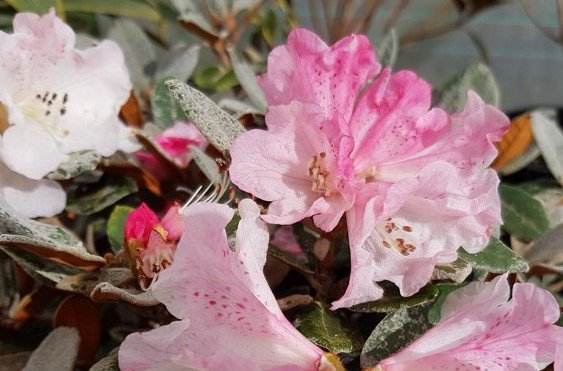
Rhododendron tsariense was first discovered by R. E. Cooper in June 1915 at Pumthang, in Bhutan—later by Ludlow and Sherriff in south Tibet, and Kingdon Ward found it in Assam in 1938. In each case growing on rocky hill sides and in rhododendron and conifer forests. There are two forms usually found in cultivation: a compact rounded shrub up to half a meter high and wide, and a broadly upright shrub to 1.5 meters high. The small leathery leaves are elliptic or oblong-elliptic, upper surface dark green (the young leaves are covered with tomentum), under side is covered with a thick woolly, rust-coloured or cinnamon indumentum making a very attractive plant when the white, pink or white tinged pink flowers with or without red spots appear in mid October. It’s a shrub which lends itself to being planted at eye level to view the delightful indumentum. Our plants at Emu Valley are growing in the Bhutan section of the garden.

Rhododendron coriaceum was a very early species to be planted at Emu Valley Rhododendron Garden. The single plant is located in the hybrid section because Yunnan and Tibet were not cleared until much later. Nevertheless it has formed a large shrub, and in mid September produces many large trusses of white flowers with a deep maroon blotch and a ray of dots inside the top petals of the same colour. We have now planted a number of seed-grown plants in their native areas. R. coriaceum was first discovered by Abbe Soulie in March 1895 at Tsekou, north-west Yunnan, later collected by many plant hunters in west Yunnan and in south-east Tibet, growing near conifer and other rhododendron species, at elevations of 3000-4000m. This species was first introduced by Forrest in 1918. There are two main colour forms, white and pale pink. If you wish to look for these plants the easiest one to find is on the right-hand corner of the road up to the Main Gazebo.
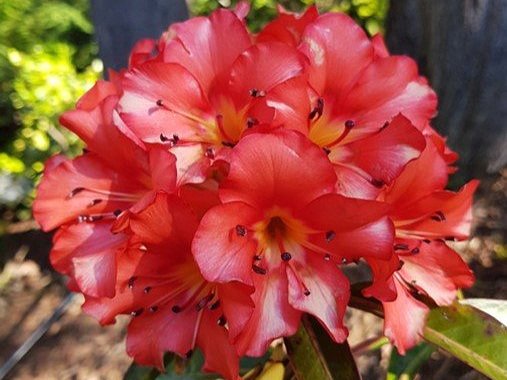
This is one of the more colourful Vireyas we have in the garden, but unfortunately its pedigree is so colourful as to go to the lengths of utterly confusing! But just let us enjoy it for how it looks and performs. This species came to us as R. javanicum ssp. Brookeanum from Dr. Noel Sullivan, and was one of the first to be planted in our Vireya Section. So that is about 30 years ago. About the confusion: there are at least 10 different subspecies. R. brookeanum is described as “leaves in tight to loose pseudo-whorls, flowers mostly uniformly coloured.” No prizes for guessing where it comes from though – Java obviously, and Sumatra and Borneo – the Indonesian archipelago in fact. There was great excitement at the time of discovery, as orange flowers were a rarity. Ours could be described as orange-pink with a cream centre, but the full truss looks more like R. javanicum ssp javanicum and the leaves also more like J/J—being narrowly elliptic initially laxly scaly both sides, losing them on top pretty quickly, while more persistent underneath and eventually spotted brown after the scales have gone. Anyway, whatever the name, it is growing quite well and flowers are delightful as you will agree, usually produced in November.
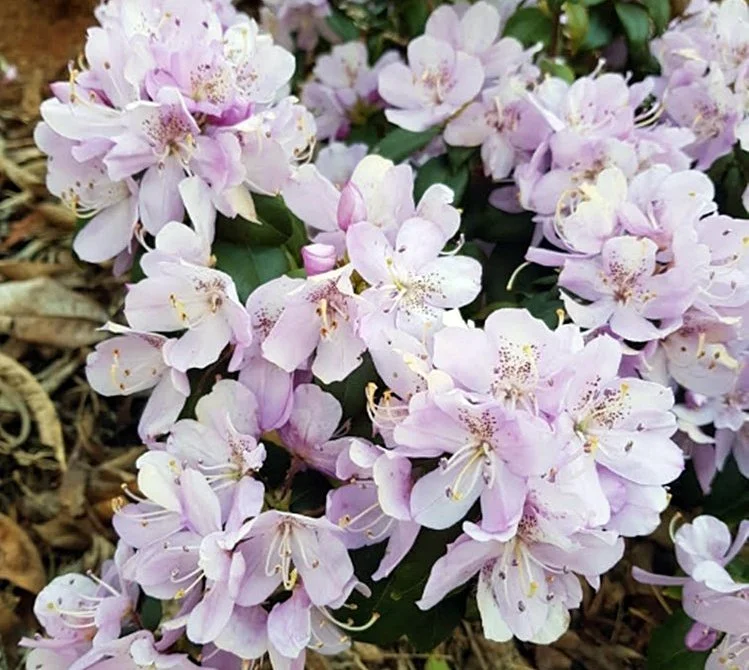
Tucked among the misty forests of northern Vietnam, Rhododendron mitriforme is a botanical gem that brings a touch of the exotic to cool-climate gardens. First described by botanist D. F. Chamberlain in the late 20th century, this species is prized for its compact form and delicate floral display. Typically growing to around 1.5 metres in height, R. mitriforme is a small evergreen shrub with leathery, dark green leaves and a tidy, rounded habit. In late spring, it produces clusters of soft pink to pale rose tubular flowers, often with subtle spotting inside the corolla. The blooms are modest in size but striking in their elegance—perfect for collectors and enthusiasts who appreciate subtlety over spectacle. This rhododendron thrives in dappled shade with well-drained, acidic soil rich in organic matter. It prefers cool, moist conditions and benefits from protection against harsh afternoon sun and drying winds. Though still rare in cultivation, R. mitriforme is a rewarding choice for sheltered woodland gardens and shaded borders. Keep an eye out for this understated beauty on your next visit—it’s a quiet achiever with undeniable charm that you can find around the Japanese Tea House carpark at the Emu Valley Rhododendron Garden.
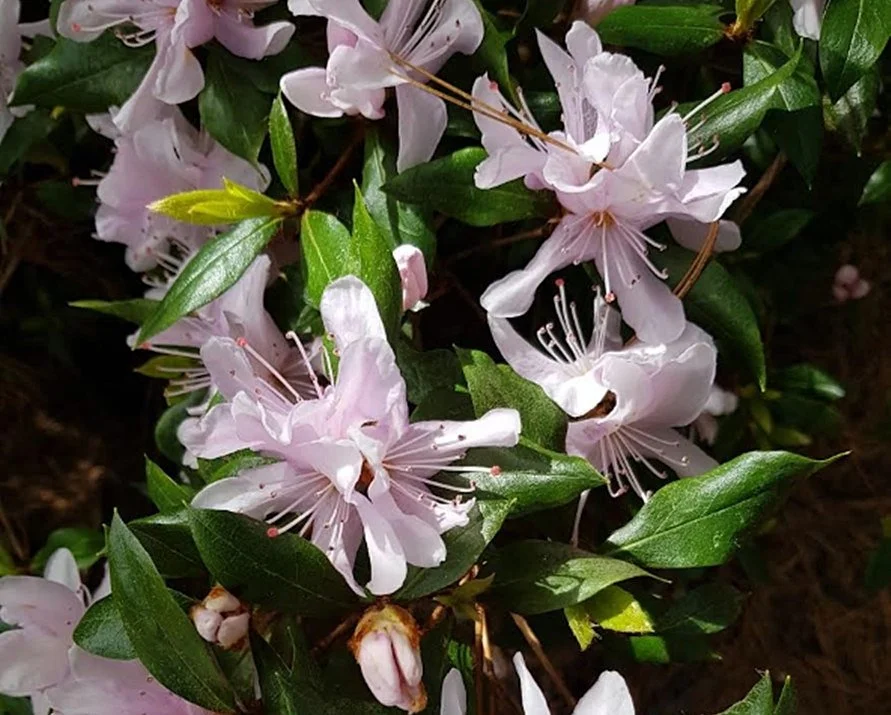
Rhododendron rubropilosum is an evergreen azalea found growing on Mt. Morrison Taiwan on grass covered slopes at elevations of 2400-3400m, where it grows into an upright shrub from 1-3m high (around 2m in our garden). The young shoots are covered with grey or reddish-brown hairs. Leaves are oblong-lanceolate or elliptic-lanceolate, the upper surface dark green, under surface pale green, both surfaces have scattered hairs similar hairs to the shoots. Flowers are funnel shaped, pale pink sometimes spotted rose and usually appear in clusters of 3-4 in September early October. Rhododendron rubropilosum is closely related to R. subsessile, the main difference is the flowers are violet-purple or rose-pink on R. subsessile and the stamens are longer and is native to the Philippine Islands. This species was first collected by G. Nakahara in 1906 and was introduced by Wilson in 1918 and by J.L. Creech in 1968. At the Emu Valley Rhododendron Garden it is growing quite well and can be seen on either side of the Noel Sullivan walk in our Taiwan section.
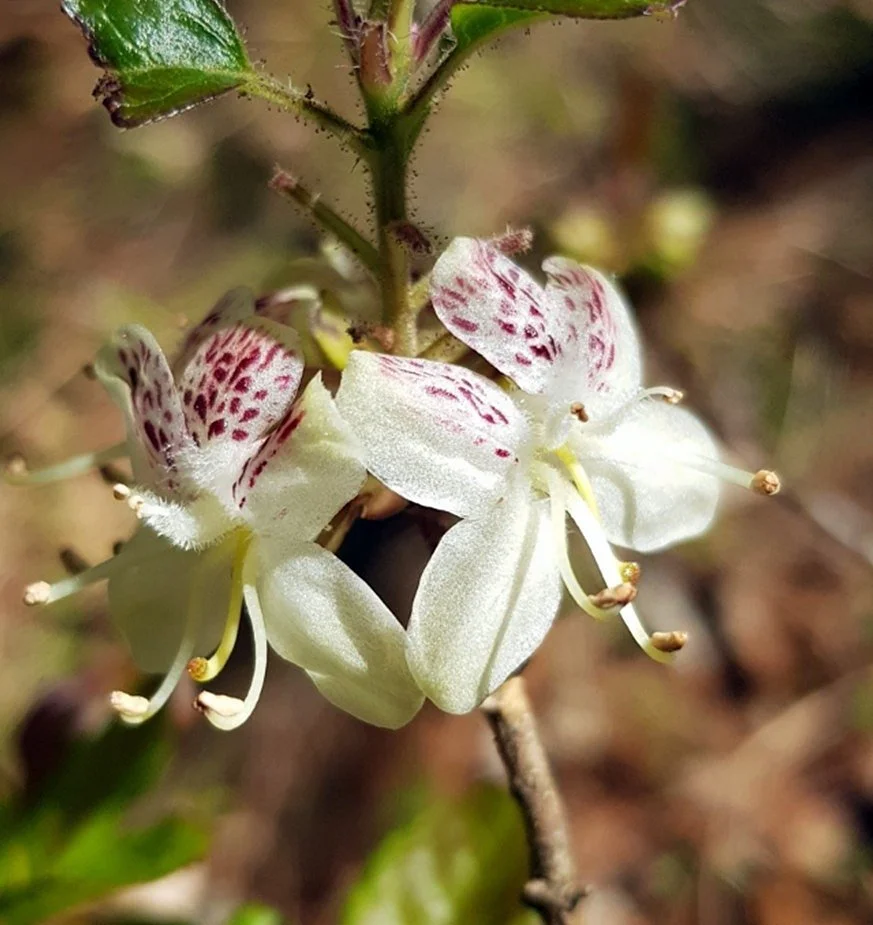
Here is a rather unique, although not a very showy rhododendron from the wooded mountains of Honshu., Shikoku and Kyushu Japan. The Japanese plant collector Tschonoski discovered and first introduced this species around 1870 and by Wilson in 1914 when he sent seed to the Arnold Arboretum. R. semibarbatum forms an upright bushy shrub 0.6 – 2 m high in the wild but usually half this height in gardens. The branchlets are pubescent glandular with long stalked glands, the leaves are elliptic- ovate, the upper surface dark green, the under surface pale green. The margins are covered with small bristles and flower buds are produced crowded underneath these leaves at the ends of the branchlets, and appear at the same time as the leaves. The rotate-campanulate flowers are small 1.5-2 cms wide white, white flushed pink with red spots at the base of the lobes, the stamen are partly covered with white hairs. The flowers tend to be lost underneath the leaves. These plants are more for the enthusiast collector than the home gardener.
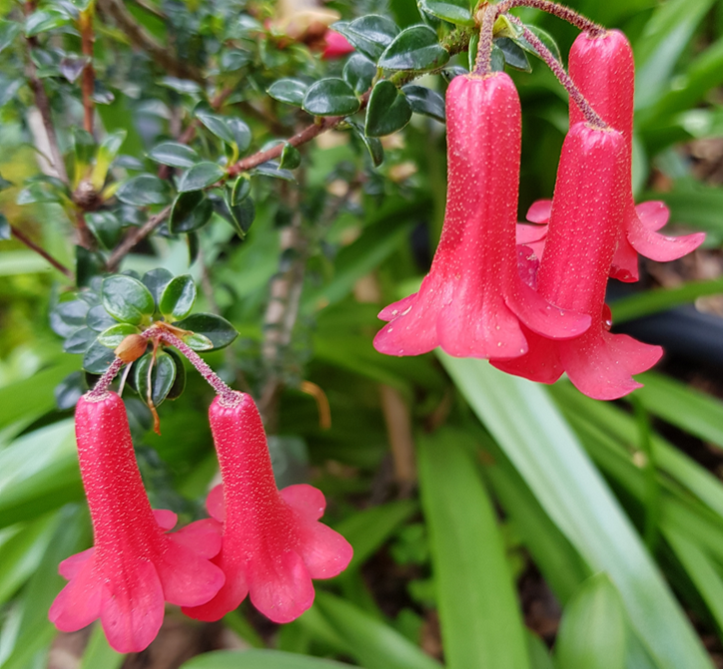
This delightful vireya rhododendron can be found growing on the Eastern, Western and Southern Highlands of Papua New Guinea, where it forms an erect shrub to 2m high, the smaller branches are densely clothed with brownish scales. The small dark green leaves are arranged in a spiral formation. These leaves are less than 10 mm long, ovate-elliptic to rounded, pointed at the apex, shiny on the upper surface, with the under surface paler—usually with a scattering of scales. The bright to deep red flowers hang on stout pedicels, which are densely covered with scales as are the flowers giving them a white spotted appearance. At Emu Valley Rhododendron Garden we are growing a number of plants of this species, our climate seems to suit them and with some T.L.C. should grow into interesting plants. Rhododendron womersleyi was named after John Womersley, botanist in Lae Papua New Guinea with a deep interest in Rhododendrons. Introduced into Australia by L.K. Wade in 1966.
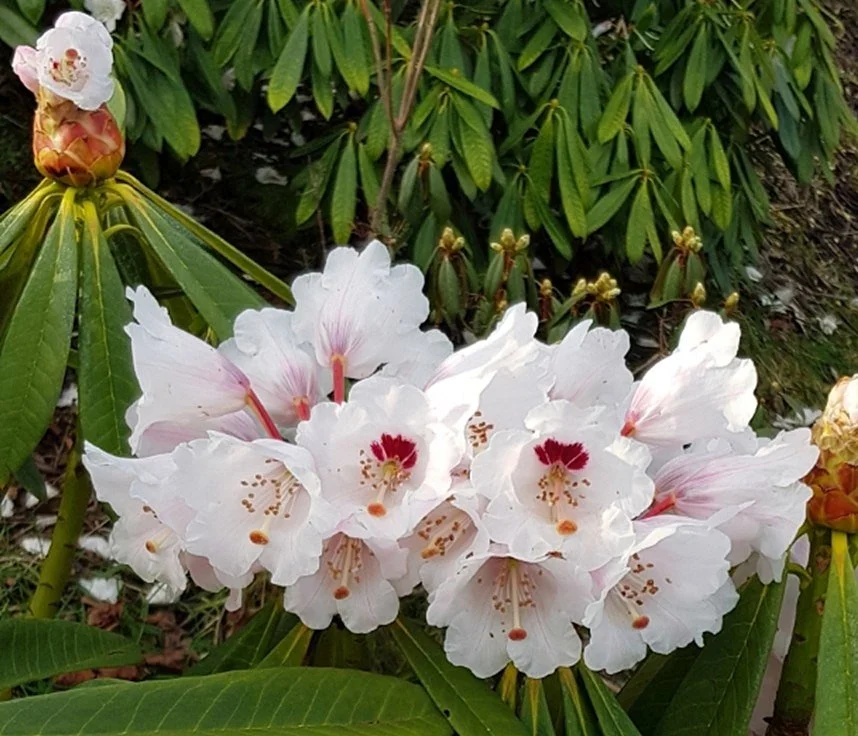
We have waited quite a while for R calophytum to flower. However the wait is over and we now have six plants with flowers, all the same colour, but beautiful. R calophytum is a native of western Sichuan, where it can grow to 15m. Hopefully less than half that here, but still quite spectacular. It was described by Franchet in 1886 from plants collected at Moupin, where it was found growing in woods and forests. Other collectors noted that it was common in the forests of western Sichuan. It was introduced by Wilson in 1904 and many times since by others. R calophytum has large leathery oblanceolate leaves up to 30cm. Long, upper surface glabrous, under surface covered with scattered hairs. The flower truss is also large, having up to 30 widely campanulate flowers, which can be white, white tinged pink, pink or purple with a dark blotch at the base. The plants growing at Emu Valley are to be found in the Sichuan section in the NE corner of the garden. All have white flowers with a red blotch at the base. There are still more plants to flower, maybe a different colour.
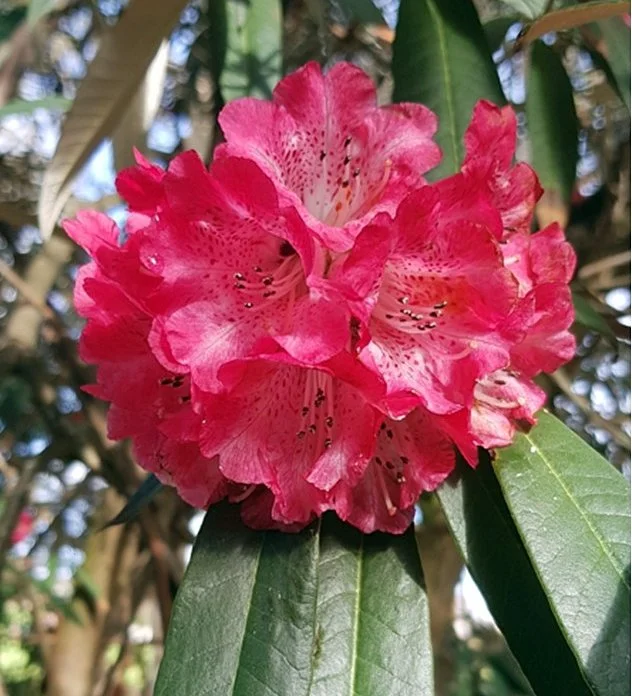
The very existence of this plant we owe thanks to the late Dr. Noel Sullivan. Noel was an authority on all things Rhododendron and in his lifetime he became a world renowned authority. He presented a Baron von Meuller Memorial address in 1997 in Melbourne. On a trip to Sikkim in the Himalayas he came across a stand of R. arboreum ssp arboreum and noticed an interesting form of this species. Some of the seed found its way into the cuff of his trousers, which he successfully raised to become the much loved plant we now enjoy. He registered this plant in 1991 as ‘Stowport’ coming as it did from his extensive garden at Stowport not far from Burnie. Now for the statistics as recorded in its registration. Flowers 37 in the truss, campanulate 50 x 35 mm vivid red paling to near white at the base, nectaries black-red. Leaves narrow elliptic 170 x 30 mm with plastered silver indumentum below.



